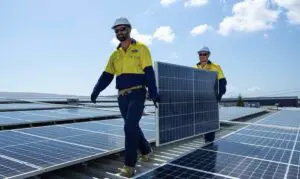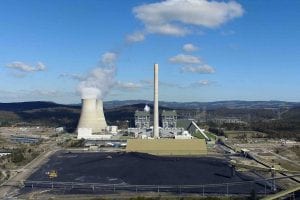The federal Coalition government has finally decided to extending the funding for the Australian Renewable Energy Agency, but will – as predicted – push both ARENA and the Clean Energy Finance Corporation away from wind and solar into other “low emission” technologies, including carbon capture and storage.
ARENA and CEFC have played critical roles in advancing Australian renewable, storage and other critical enabling technologies since their creation in 2012, and despite repeated attempts by the Coalition government to dismantle them, and severe cuts to ARENA’s original budget.
ARENA – which is now nearly exhausted of funds, and had its board recently stacked with Coalition favourites – is to be given “guaranteed baseline funding” of $1.427 billion over the next 10 years, and will be given extra allocations in the annual budget. For 2020/21, that will amount to $191 million.
This is part of a $1.9 billion package to the two green funds that will include money for CCS, a regional hydrogen hub, along with many of the project identified by a group led by former Origin Energy CEO Grant King, and even some money for pubs to upgrade their refrigeration systems.
The government will change the mandates of both ARENA and the CEFC so they can more or less follow the government’s Technology Roadmap which is to be finalised in the next couple of weeks, and which looks at technologies beyond wind and solar, including gas, hydrogen and CCS.
The push to broaden the mandate into “low emissions” technologies will require parliamentary approval – rejected by the Senate when the Coalition first tried to scrap the bodies – and comes just days after the unveiling of a major gas package, and the government’s extraordinary ultimatum to build a 1GW gas plant in the Hunter Valley.
“Solar panels and wind farms are now clearly commercially viable and have graduated from the need for government subsidies and the market has stepped up to invest,” prime minister Scott Morrison said in a joint statement with energy minister Angus Taylor.
“We will reduce the cost of new and emerging technologies, not raise the cost of existing technologies or layer in new costs to consumers and businesses through mandated targets or subsidies.,” Taylor added.
“The government recognises the strong growth in emerging energy technologies that will play a role in Australia’s energy mix into the future. We need to get the balance right and our investment to re-energise ARENA will deliver that.”
Taylor said the focus of the new funding would be on reducing emissions outside of the electricity grid, including in manufacturing, transport and agriculture.
“We need to work out how to decarbonise industry. Carbon capture is one of many technologies that can decarbonise industry,” Taylor told the ABC. “If we constrain ARENA and the CEFC … two thirds of emissions (in the economy beyond electricity) will not be addressed.”
Included in the broader $1.9 billion funding package is $50 million for CCS – clearly the most controversial of the initiatives given the more than $1 billion already spent by various government grants on the technology that has so far failed to deliver any notable abatement.
The document released by the government says CCS projects will look at power generation, gas, manufacturing and cement. Potential CCS hubs include Moomba (SA) Surat/Bown Basins (Qld), offshore Latrobe Valley (Vic), offshore Darwin (NT), and the Pilbara/Carnarvon Basin (WA), along with Browse (WA).
Low Emissions Technology, a group funded by the coal industry, said it looked forward to gaining more government money to advance an integrated CCS project in Queensland, which it said would involve the “capture, transport and safe, permanent storage” of CO2 from a coal fired power station.
However, the Investor Group on Climate Change warned that fund managers were not interested in CCS in the power industry. “Institutional investors have little appetite to allocate capital to legacy technology such as fossil fuels with carbon capture, utilisation and storage in the electricity sector,” it said in a statement.
Another $70.2 million will be spent on establishing a “regional” hydrogen export hub, which could be cited in the Latrobe Valley (Vic), or Darwin (NT), north-west WA, Gladstone (Qld), Hunter Valley (NSW), Bell Bay (Tasmania) and the Spencer Gulf (South Australia).
Another $50 million will go to energy efficiency measures for homes and commercial buildings, and $95.4 million will go into a Technology Co-Investment Fund.
A further $67 million will be allocated on renewable and battery storage micro-grids for remote areas including mines, farms and communities currently reliant on expensive diesel.
The government has also allocated $74.5 million will given to a “future fuels fund”, which will focus on “refuelling stations” for hydrogen, electric or bio-fuelled vehicles.
Other funding initiatives include $24.6 million will go to the Clean Energy Regulator to expand and accelerate projects that can develop carbon credits.
He noted that ARENA has helped to improve the competitiveness of renewable energy technologies such as large scale solar, grid scale batteries, pumped hydro, bioenergy, distributed energy technologies and hydrogen. Since 2012, it has supported 543 projects with $1.58 billion of funding that has leveraged nearly $5 billion in additional private and public sector investment.
The Australian Conservation Foundation said it was concerned that the government continues to throw money at fossil fuels.
“The $1.4 billion for the Australian Renewable Energy Agency over the next decade represents a funding cut, based on the agency’s historical funding, while expanding its work to invest in dirty technologies,” said ACF’s climate program manager Gavan McFadzean.
“Broadening the mandates of the Clean Energy Finance Corporation and the Australian Renewable Energy Agency to force them to invest in gas and unproven carbon capture and storage is an unnecessary and dangerous turn.
“Carbon capture and storage has already received $1.3 billion in taxpayer support with almost no commercial successes. It is not reliable or cost effective and should not be used as an excuse to prolong the use of coal, oil and gas at a time of already severe climate change.”







